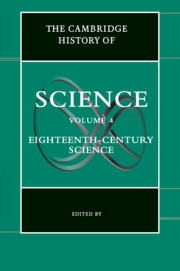Book contents
- Frontmatter
- 1 Introduction
- Part I Science and Society
- Part II Disciplines
- Part III Special Themes
- 22 Eighteenth-Century Scientific Instruments and Their Makers
- 23 Print and Public Science
- 24 Scientific Illustration in the Eighteenth Century
- 25 Science, Art, and the Representation of the Natural World
- 26 Science and Voyages of Discovery
- Part IV Non-Western Traditions
- Part V Ramifications and Impacts
- Index
- References
25 - Science, Art, and the Representation of the Natural World
from Part III - Special Themes
Published online by Cambridge University Press: 28 March 2008
- Frontmatter
- 1 Introduction
- Part I Science and Society
- Part II Disciplines
- Part III Special Themes
- 22 Eighteenth-Century Scientific Instruments and Their Makers
- 23 Print and Public Science
- 24 Scientific Illustration in the Eighteenth Century
- 25 Science, Art, and the Representation of the Natural World
- 26 Science and Voyages of Discovery
- Part IV Non-Western Traditions
- Part V Ramifications and Impacts
- Index
- References
Summary
No interested person in the eighteenth century would have accepted the recent insistence by a professor of biology and publicizer of science that art and science are entirely separate and different disciplines. Nobody was astonished in 1760, when the Society for the Encouragement of the Arts, Manufactures and Commerce, founded to promote scientific inventions for the benefit of the national economy, staged the first public art exhibition in Great Britain. In an age when politicians, scientists, and artists met in coffeehouses and clubs and debated subjects ranging from natural history to political scandals, the boundaries between art and science were not clearly marked. In eighteenth-century Europe, botany was not only a cutting-edge science but also the favorite subject matter for the drawings of aristocratic ladies; those who collected and classified shells were also the arbiters of Rococo taste, and the foremost anatomists were employed by art academies to lecture to their students. Each of these areas would be a suitable subject for a chapter dedicated to science and art in the eighteenth century. So, too, might the way that some artists represented the activities of experimental scientists and technologists. Yet it was not such experimental investigators but rather the “natural historians“ – descriptive explorers of the natural world – who were the central figures in the age of the Cult of Nature, and it is their concerns that intersect most clearly with those of artists in the eighteenth century. It is on the changing perceptions of landscape as they developed among artists and natural historians that this chapter will concentrate.
- Type
- Chapter
- Information
- The Cambridge History of Science , pp. 584 - 617Publisher: Cambridge University PressPrint publication year: 2003
References
- 1
- Cited by

